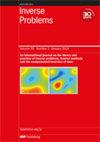fg-ORKA: fast and gridless reconstruction of moving and deforming objects in multidimensional data
IF 2.1
2区 数学
Q1 MATHEMATICS, APPLIED
引用次数: 0
Abstract
Identifying and tracking objects over multiple observations is a frequent task in many applications. Traffic monitoring requires the tracking of vehicles or pedestrians in video data and geophysical exploration relies on identifying seismic wave fronts from data of multiple sensors, only to mention two examples. In many cases, the object changes its shape or position within the given data from one observation to another. Vehicles can change their position and angle relative to the camera while seismic waves have different arrival times, frequencies, or intensities depending on the sensor position. This complicates the task at hand. In a previous work, the authors presented a new algorithm to solve this problem—object reconstruction using K-approximation (ORKA). This algorithm is hindered by two conflicting limitations: the tracked movement is limited by the sampling grid while the complexity increases exponentially with the resolution. We introduce an iterative variant of the ORKA algorithm that is able to overcome this conflict. We also give a brief introduction on the original ORKA algorithm. Knowledge of the previous work is thus not required. We give theoretical error bounds and a complexity analysis which we validate with several numerical experiments. Moreover, we discuss the influence of different parameter choices in detail. The results clearly show that the iterative approach can outperform ORKA in both accuracy and efficiency. On the example of video processing we show that the new method can be applied where the original algorithm is too time and memory intensive. Furthermore, we demonstrate on seismic exploration data that we are now able to recover much finer details on the wave front movement then before.fg-ORKA:多维数据中移动和变形物体的快速无网格重建
在许多应用中,识别和跟踪多个观测对象是一项经常性任务。交通监控需要跟踪视频数据中的车辆或行人,地球物理勘探需要从多个传感器的数据中识别地震波前沿,这只是其中的两个例子。在许多情况下,从一次观测到另一次观测,物体在给定数据中的形状或位置都会发生变化。车辆相对于摄像机的位置和角度会发生变化,而地震波的到达时间、频率或强度则会因传感器位置的不同而不同。这使得手头的工作变得更加复杂。在之前的一项研究中,作者提出了一种解决这一问题的新算法--使用 K 近似法(ORKA)进行目标重建。该算法受到两个相互冲突的限制的阻碍:跟踪运动受到采样网格的限制,而复杂度则随着分辨率的增加呈指数增长。我们介绍了 ORKA 算法的迭代变体,它能够克服这一矛盾。我们还简要介绍了原始 ORKA 算法。因此不需要了解以前的工作。我们给出了理论误差范围和复杂性分析,并通过几个数值实验进行了验证。此外,我们还详细讨论了不同参数选择的影响。结果清楚地表明,迭代法在精度和效率上都优于 ORKA。以视频处理为例,我们表明新方法可以应用于原始算法时间和内存消耗过大的地方。此外,我们还在地震勘探数据上证明,我们现在能够恢复比以前更精细的波前运动细节。
本文章由计算机程序翻译,如有差异,请以英文原文为准。
求助全文
约1分钟内获得全文
求助全文
来源期刊

Inverse Problems
数学-物理:数学物理
CiteScore
4.40
自引率
14.30%
发文量
115
审稿时长
2.3 months
期刊介绍:
An interdisciplinary journal combining mathematical and experimental papers on inverse problems with theoretical, numerical and practical approaches to their solution.
As well as applied mathematicians, physical scientists and engineers, the readership includes those working in geophysics, radar, optics, biology, acoustics, communication theory, signal processing and imaging, among others.
The emphasis is on publishing original contributions to methods of solving mathematical, physical and applied problems. To be publishable in this journal, papers must meet the highest standards of scientific quality, contain significant and original new science and should present substantial advancement in the field. Due to the broad scope of the journal, we require that authors provide sufficient introductory material to appeal to the wide readership and that articles which are not explicitly applied include a discussion of possible applications.
 求助内容:
求助内容: 应助结果提醒方式:
应助结果提醒方式:


